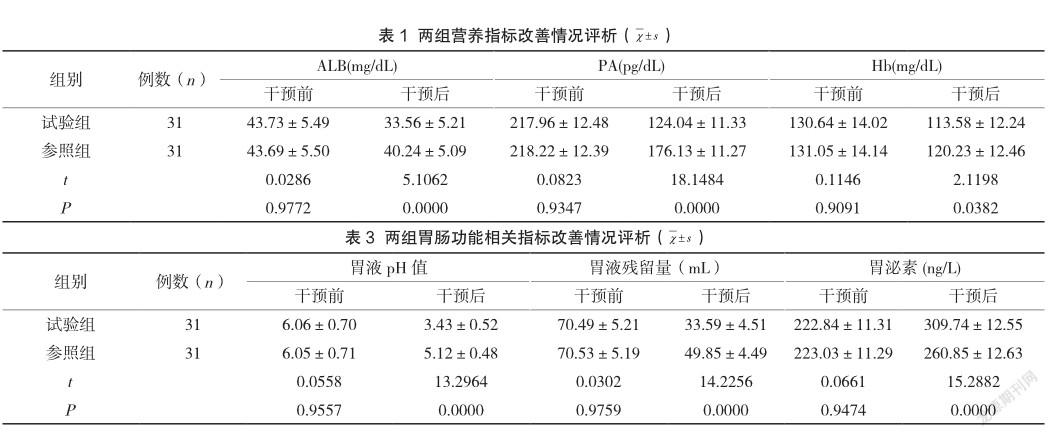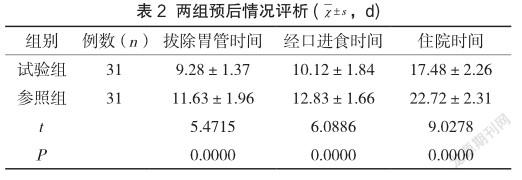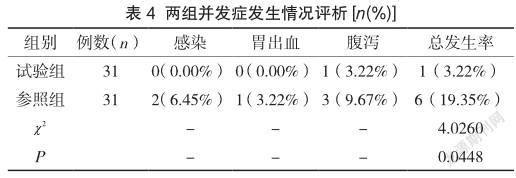腸內營養護理指引在腦外傷危重患者中的實施價值
楊芳
【摘 要】目的:研究、討論腦外傷危重癥患者護理中,將腸內營養護理作為方案的臨床意義。方法:選取2020年3月至2021年10月的腦外傷危重患者62例,患者分至不同組別,執行奇偶分組法。其中31例歸至參照組,腦外傷常規護理。其余31例納入試驗組,場內營養護理。對兩組營養指標改善情況、預后情況、胃腸功能相關指標改善情況、并發癥發生情況進行統計、處理。結果:(1)各項營養指標經由分析可知,干預前,參照組、試驗組數據分布較為均衡(P>0.05)干預后,試驗組ALB(血漿白蛋)、PA(血漿前白蛋白)、Hb(血紅蛋白)水平均下降,且較參照組低(P<0.05)。(2)各項預后情況指標經由分析可知,拔除胃管、經口進食、住院時間方面,均為試驗組數值更小(P<0.05)。(3)各項胃腸功能相關指標經由分析可知,干預前,參照組、試驗組差異性較弱(P>0.05)。干預后,試驗組胃液pH值、胃液殘留量比參照組低,胃泌素水平比參照組高(P<0.05)。(4)各項并發癥指標經由分析可知,感染、胃出血、腹瀉等發生概率方面,均為參照組更高(P<0.05)。結論:腦外傷危重患者護理中,將腸內營養護理護理作為措施,價值顯著。患者胃腸功能提升的同時,營養指標得到改善,并且并發癥發生概率減少,預后效果優異。
【關鍵詞】腦外傷;腸內營養護理;危重;臨床價值
The implementation value of enteral nutrition nursing guidelines in critical patients with brain trauma
YANG Fang
Taizhou Hospital of Traditional Chinese Medicine, Taizhou, Jiangsu 225300, China
【Abstract】Objective: To study and discuss the clinical significance of enteral nutrition nursing as a scheme in nursing critical patients with brain trauma. Methods: From March 2020 to October 2021, 62 critically ill patients with brain trauma were enrolled. Patients were divided into different groups, and parity grouping was performed. Among them, 31 cases were assigned to the reference group and received routine nursing care for traumatic brain injury. The remaining 31 cases were included in the experimental group, and nutrition nursing was performed on site. The improvement of nutritional indexes, prognosis, improvement of gastrointestinal function related indexes and occurrence of complications in the two groups were counted and processed. Results: (1) According to the analysis of various nutritional indexes, before the intervention, the data distribution of the reference group and the experimental group was relatively balanced(P>0.05).After the intervention, the levels of ALB (plasma white egg), PA (plasma prealbumin) and Hb (hemoglobin) in the experimental group decreased, and were lower than those in the reference group(P<0.05).(2) According to the analysis of various prognostic indicators, the values of extubation, oral feeding and hospital stay in the experimental group are smaller(P<0.05).(3) The analysis of gastrointestinal function related indexes shows that before the intervention, the difference between the reference group and the experimental group is weak(P>0.05).After the intervention, the gastric juice pH and gastric juice residue in the experimental group were lower than those in the reference group, and the gastrin level was higher than that in the reference group(P<0.05).(4) Through the analysis of various complications indicators, it can be seen that the occurrence probability of infection, gastrorrhagia and diarrhea is higher than that of the reference group(P<0.05).Conclusion: In the nursing of critical patients with brain trauma, enteral nutrition nursing is a significant measure. The patients’ gastrointestinal function was improved, the nutritional index was improved, the probability of complications was reduced, and the prognosis was excellent.
【Key Words】Brain trauma; Enteral nutrition nursing; Critical; Clinical value
腦外傷在臨床較為多見,患者多處于昏迷狀態,嚴重影響代謝功能。機體代謝異常可誘發營養不良,進而削弱免疫功能,引發一些列并發癥[1]。為此,予以腦外傷危重患者腸內營養護理非常關鍵。臨床研究發現,腸內營養支持可恢復患者腸道健康,糾正代謝紊亂[2]。本研究選入62例腦外傷危重患者,對腸內營養護理應用其中的臨床意義進行研究、分析,報告如下。
1.1 臨床資料
錄入對象:腦外傷危重患者,62例。錄入最初、最終時間:2020年3月、2021年10月。奇偶分組法分組。參照組31例,男16例,女15例,年齡26歲~66歲,平均年齡(40.52±1.17)歲;試驗組31例,男17例,女14例,年齡25歲~65歲,平均年齡(40.39±1.22)歲。檢驗、評析兩組常規資料,未見突出差異(P>0.05),研究意義存在。選入根據:(1)處于昏迷狀態患者。(2)存在意識障礙患者。(3)自愿參與本研究患者。排除根據:(1)伴有感染性疾病患者。(2)伴有胃腸道疾病患者。

1.2 方法
參照組:常規護理。護理人員予以患者腸外營養支持。建立靜脈通道,輸注氨基酸、葡萄糖等。干預1周后,置入胃管,采用鼻飼腸內營養供給方案。
試驗組:予以患者腸內營養護理方案,具體內容如下表述:(1)置管。腦外傷危重患者多處于昏迷狀態,并且無意識。因此,在置管時需要兩名或兩名以上護理人員相互配合。(2)營養物質提供。予以患者營養液前,需要對其進行加溫處理,目的是減少腸痙攣發生。(3)腸內營養基礎護理。營養液輸注前,護理人員需要對其濃度、用量進行調整,輸注過程中應確保速度合適。
1.3 觀察指標
對兩組營養指標改善情況、預后情況、胃腸功能相關指標改善情況、并發癥發生情況進行統計、處理。
1.4 統計學方法
采用SPSS 21.0統計學軟件進行數據分析。計數資料采用(%)表示,進行χ2檢驗,計量資料采用(χ±s)表示,進行t檢驗,P<0.05為差異具有統計學意義。
2.1 兩組營養指標改善情況評析
各項營養指標經由分析可知,干預前,參照組、試驗組數據分布較為均衡(P>0.05)。干預后,試驗組ALB、PA、Hb水平均下降,且較參照組低(P<0.05),見表1。
2.2 兩組預后情況評析
各項預后情況指標經由分析可知,拔除胃管、經口進食、住院時間方面,均為試驗組數值更小(P<0.05),見表2。

2.3 兩組胃腸功能相關指標改善情況評析
各項胃腸功能相關指標經由分析可知,干預前,參照組、試驗組差異性較弱(P>0.05)。干預后,試驗組胃液pH值、胃液殘留量比參照組低,胃泌素水平比參照組高(P<0.05),見表3。
2.4 兩組并發癥發生情況評析
各項并發癥指標經由分析可知,感染、胃出血、腹瀉等發生概率方面,均為參照組更高(P<0.05),見表4。

腦外傷多由交通事故、跌倒等外力作用導致。腦外傷患者存在不同程度的昏迷癥狀。相關研究發現,腦外傷患者在昏迷狀態下,機體代謝功能難以正常發揮,進而導致脂肪、能量被過度消耗。在此情況下,患者機體免疫功能難以對抗病毒、細菌入侵,最終誘發感染,影響預后效果[3]。
總而言之,在腦外傷危重患者護理中,采用營養腸內營養護理干預方案,效果理想。除改善患者胃腸道功能、營養狀況外,還可減少并發癥發生,縮短患者住院時間。
參考文獻
[1] 王夢寒,杜娟,陳璐瑤,等.早期腸內營養護理對腦外傷昏迷患者營養指標及免疫功能的影響[J].實用婦科內分泌電子雜志,2020,7(28):83-84.
[2] 楊楠.早期腸內營養護理對腦外傷昏迷患者的效果探討護理[J].中國醫藥指南,2020,18(15):249-250.
[3] 仇爾寧,蘇杭,容耔耘.生長激素聯合腸內營養對腦外傷昏迷患者營養狀況的影響研究[J].吉林醫學,2020,41(1):145-147.

